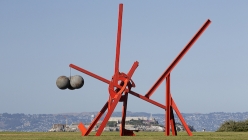Now that the San Francisco Museum of Modern Art has shuttered its Third Street location for the next two and a half years to create a home for the Doris and Donald Fisher Collection, we can expect a lot more exhibitions like Mark di Suvero at Crissy Field, which continues through May 26, 2014. This month, SFMOMA’s programming includes an exhibition of work from the museum’s collection at the nearby Contemporary Jewish Museum, and in November, two exhibitions will be mounted down on the peninsula; a co-curated effort at Stanford’s Cantor Arts Center, as well as a show of indoor and outdoor pieces in Los Altos.
The reception to the di Suvero exhibition, which features eight sculptures, each weighing upwards of 20 tons, has been perhaps a bit noisier than organizers might have expected, thanks, in part, to an article in The Atlantic Cities, which publicized an online petition (at change.org, no less) demanding the removal of di Suvero’s sculptures on the grounds that they “impede our freedom to move, and generally diminish the natural beauty of Crissy Field.” At last check, the petition had failed to reach even its modest goal of 100 signatures.

Mark di Suvero, Mother Peace, 1969-70. Photo by Ben Marks.
Please. While there are a few problems with this collection of di Suveros curated by SFMOMA’s director, Neal Benezra, those ain’t them. I’m pretty sure I’m not the first to point out that while Crissy Field may be beautiful, there is little about it that’s natural. This former marsh was destroyed for an airfield before it became a lawn where people could toss Frisbees for their defecating dogs. As for its neighbor the Golden Gate Bridge, Google “Ansel Adams Golden Gate 1933” to see the natural wonder that our most famous postcard icon ruined forever. Maybe we should remove that, too.
But I digress. For those familiar with di Suvero’s work, the exhibition at Crissy Field is a welcome chance to see a few old friends, notably Are Years What? (for Marianne Moore) (1967), one of the crown jewels of the Hirshhorn Museum in Washington, D.C. Even better is the return of the 42-foot-tall Mother Peace (1969-70), which was removed in 1974 from its location outside the Alameda County Courthouse in Oakland before being exiled to that petting zoo for sculpture, the Storm King Art Center in New York. Once Mother Peace was deemed too political because of the peace symbol cut into one of its horizontal beams. Today people complain it blocks their view of a six-lane freeway.





